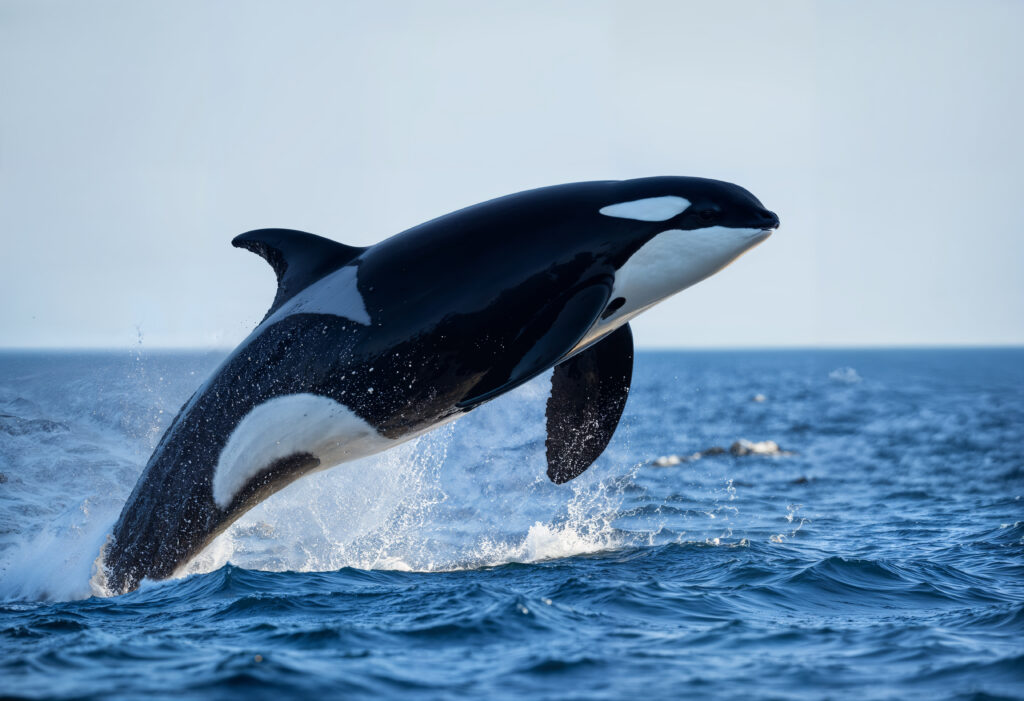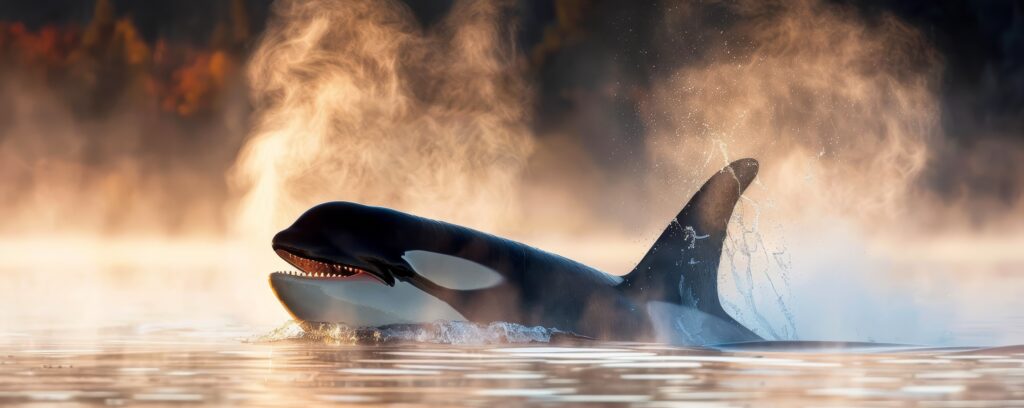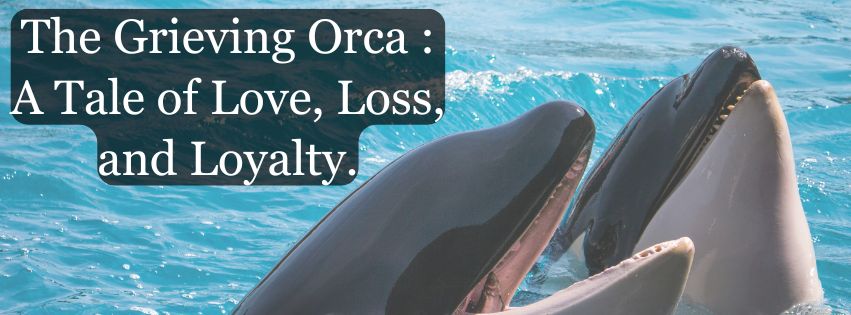In recent days most of you must have come across this news of “Grieving Orca” carrying the lifeless body of her calf. This orca is a member of critically endangered Southern Resident killer whale population, found in the Pacific Northwest. This event reflects her mourning behavior for the loss of her offspring. It is a mirror image of what happened in 2018, when she carried her dead calf for 17 days. That calf had tragically died just a few hours after birth.
In this blog we’ll explore the tale of this “Grieving Orca” that will help us understand the love, loss and loyalty of the organisms for each other and how human activities are triggering this heartbreaking events and pushing them towards extinction.
Beneath the Surface, The Orca Grieves Again
The recent event in December 2024 was a striking repetition of a past tragedy. It mirrored the incident that captivated the world in the summer of 2018. That earlier event was both extraordinary and heartbreaking.
“Tahlequah – A Grieving Orca,” also known as J35, is a 20-year-old orca from the Southern Resident killer whale population in the Pacific Northwest. She gave birth to a calf that tragically lived for only a few hours. But what happened next highlighted the incredible depth of emotion and connection in one of the ocean’s most intelligent species.
For 17 days and more than 1,000 miles, “Tahlequah – The Grieving Orca” refused to let go her dead calf and carried it through the water. Her act of mourning is a heart wrenching reminder of the emotional bonds the animals share and the urgent need to protect their fragile ecosystem.
Who Is this Grieving Orca, and Why this event is noteworthy?

This grieving orca is named Tahlequah, also known as J35, is a member of the critically endangered Southern Resident killer whale population, a group of orcas (killer whales) found in the Pacific Northwest. There are only 75 living individuals as of 2025.
Known for their intelligence and close family ties, orcas often live in close-knit groups. These groups depend on one another for survival, traveling the oceans together in search of food, safety and companionship. The loss of a member has a profound impact, and scientists have observed grief behavior in orcas before. However, Tahlequah’s prolonged mourning was extraordinary.
Surprisingly the mother pushed her calf’s dead body to the surface of the water for nearly three weeks. She balanced it on her nose or swam underwater to keep it from drowning. In similar fashion the other members of her herd joined her. These members took turns carrying the calf and making sure “Tahlequah – The Grieving Orca” had enough time to grieve. This act of unity emphasizes the loyalty and love that defines orca families.
Research on whales, dolphins and porpoises has revealed their highly developed brain’s capability of reciprocation to complex emotions. Orcas have spindle cells, which are associated with empathy and grief, suggesting that their grieving behavior is similar to ours.
“Tahlequah – The Grieving Orca” grief journey was not just an instinctive response, but a deeply emotional reaction – a proof to the orca’s capacity for love, loss, and loyalty.
Want to know more about Orca, read –
https://en.wikipedia.org/wiki/Orca
A Cry Beneath the Surface: A Grieving Orca in a Collapsing Ecosystem
Tahlequah – The Grieving Orca’s heartbreaking episode highlighted the grim situation faced by her species. Their dwindling population states the tragedy of survival in changing conditions laying them in jeopardy. They are in danger due to the combination of environmental, ecological and human made factors. The circumstances putting them in this position are –
Vanishing Prey: The Crisis of Food Scarcity in the Ocean
These species prey primarily on Chinook salmon, which are been largely fished commercially and human activities like deforestation, building dams, urban development is disrupting their spawning habitats.
Without sufficient food orcas are malnourished and have lower reproduction rate.
Silent Poison: The Chemical Threat Beneath the Waves
Chemicals like PCBs (polychlorinated biphenyls) and pesticides accumulate in the orca’s blubber through the food chain as they are apex predators.
These chemicals weakens their immune system, lowering reproduction rate and cause long term health problems.

The Price of Our Progress: An Orca’s Fight to Survive in a Changing Sea
Rising shipping traffic, military sonar and industrial activities create radio waves that alters orcas ability to communicate with their own species disrupting crucial activities. These waves also makes them difficult to detect salmon and hunt other preys.
Increased maritime traffic not only cause noise pollution but raises risk of collision with orcas putting them in life threatening events.
Climate change intensifies other threats to orcas like warm oceans reduce food availability, melting ice expose them to new predators, ocean acidification affects their food chain to reduce their preys. Making their survival difficult due to lack of food and increased competition.
Climate change has multiple effects like sudden rise in jellyfish which have devastating effects, read more –
Rise in global temperature leads to melting glaciers, rising sea levels and more but if glaciers melts it will expose some microbes which can be life threatening for humankind, read more –
The Battle for Birth Among Southern Resident Orcas
Orcas have slow reproductive cycle, females giving birth only once every 3-10 years. Malnourishment or pollution increases mortality rate making population recovery difficult.
Their small population leads to inbreeding resulting in lower fertility and higher vulnerability to diseases.
Monarchs of the Deep: How Orcas Captured the Ocean’s Crown
Orcas, also known as killer whales, behold some unique features in the ocean through a combination of intelligence, social complexity, ecological importance, and striking appearance. They are apex predators that have inspired, awed and fascinated, captivating scientists, conservationists, and the general public. Some of their astonishing traits not only attract attention of various individuals but also hold a vital status in ecosystem. Let’s explore some of their noteworthy qualities other than we read in recent news –
– These orca’s are top predators so regulate prey populations ensuring that no single species dominates or disrupts the ecosystem. They are also responsible to keep check hunters like seals, whales, salmon or even sharks by preying on them.
– They are one of the most intelligent marine species with advanced hunting techniques and problem solving skills.
Orca’s cooperative hunting strategies, ability to learn, and adaptive behavior are remarkable. They also teach these skills to the younger ones. This showcases their deep understanding of survival within pods or clans.
It represents a strong sense of communal bonding.
– The beauty of this organism is its iconic black-and-white coloring, make them visually captivating and easily recognizable. Their sleek powerful body with towering dorsal fins, makes them most majestic sight in the ocean.
– Orca’s have great ability to survive in varied conditions, this explains how they can be found in polar waters as well in tropical seas.
– They hold cultural and spiritual significance to many indigenous communities, particularly in the Pacific Northwest. They are often regarded as guardians, family members, or spiritual guides, emphasizing their connection to the natural world and human culture.
A Grieving Orca’s Journey: Holding On to Hope Across Generations
Tahlequah will eventually let go of her calf, but her story lives on as a powerful symbol of maternal love and resilience. Her grief touches millions around the world, reminding us that the bonds of family and loss are universal.
As we reflect on her story, let it inspire us to act. Not just to save orcas, but to honor our deep connection with the natural world.
Protecting the orca doesn’t just mean preserving a species. It means preserving a legacy of love that lasts for generations. This reminds us of the profound connections that shape life in the oceans.

Leave a Reply